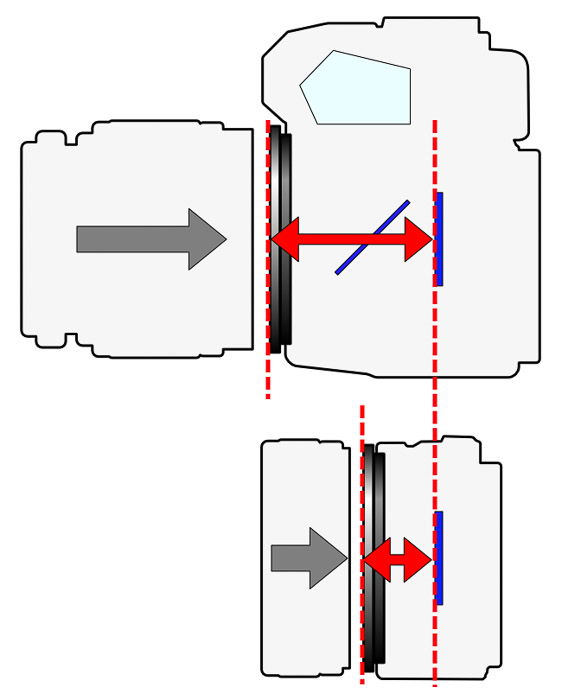You might wonder why we can’t always interchange lenses between different brands and types of cameras. Canon lenses are for Canon systems and Nikon lenses only work with Nikon systems.
Even within the same manufacturer, specific lenses are for specific cameras. Besides different protocols of connection, this all comes down to a camera’s flange distance. Read below to find out what it is.
Flange distance is the distance between the lens mount and the sensor in a camera.
It varies between manufacturers, and between types of cameras, too.
The most important factor that determines a camera’s flange distance is whether it has a mirror. A mirror mechanism increases the minimum required flange distance for a camera system.
If one would place the lens mount (and thus the rear glass elements) too far back, the mirror would hit it every time it flips.
Typically, SLR and DSLR systems, which include a mirror, have flange distances around 45mm. Specifically, Canon’s EF mount is 44mm, Nikon’s F is 46.5mm. Other DSLR mounts are similar, too. (We’ll get back soon to what this means in practice.)
Digital mirrorless (MILC) systems, which don’t have a mirror, can reduce it to less than 20mm. Sony’s E-mount has an 18mm, the MFT system has a 19.25mm flange distance.

Flange distances of a DSLR and a mirrorless camera
Camera lenses work very similarly to our eyes. If fitted correctly, they can focus to infinity (anything that’s far away), and they can focus close-up.
Most lenses focus with their rear element(s) moving. To achieve close focus, the rear element is further away from the sensor. When focusing to infinity, that element is closer to the sensor.
If the lens can’t get close enough to the sensor, it will be impossible to focus to infinity. This strongly limits the practical use of any lens, except macro lenses.
This phenomenon determines what lenses can be adapted to different camera mounts.
Flange distance defines if a certain lens can be adapted to a certain camera body.
Here’s the essence: a lens can be adapted to a camera if its intended flange distance is longer than the camera body’s flange distance.
There are a few additions to this. Even if an adaptation is possible in theory, it may not work in reality.
Lens Adapters are exactly as thick as the difference between the flanges distances of the camera and the lens. Therefore, the difference must be significant enough to let an adapter fit.
For instance, you can’t adapt an MFT lens to a Sony E-mount camera. Their difference is only 1.25mm, an adapter that thin is hardly feasible. In general, adapters for mirrorless lenses rarely exist.
The difference is only 2.5mm between the Canon EF and Nikon F mounts. That’s fairly short, but it allows for a non-electronic adapter. This means that you can adapt Nikon lenses to Canon cameras, but you won’t have aperture control and have to focus manually. But, it does not work reversed, so you can’t easily put a Canon lens on a Nikon camera.
If you plan to adapt vintage lenses that have extending parts rearwards, be careful too. You might have to physically modify the lens to fit the adapter.
If you want to adapt lenses that wouldn’t otherwise fit because of their shorter flange focal distance, there’s another option.
Optical adapters include a lens element that shifts the focus of the lens. That way, they can push infinity focus further away from the sensor.
There’s a problem, though. Most of the time these adapters drastically decrease the optical quality. They may degrade sharpness, and introduce serious color shifting or fringing.
Thus, we don’t recommend using them, unless not inescapable.
When it comes to adaptation, mirrorless mounts have a significant advantage.
Their flange distance is much shorter than anything before them. Thus, you can adapt practically any lens onto them.
Sony’s E-mount, which is the most popular full frame mirrorless mount, is the leader in this game. You can find E-mount adapters to any almost any lens from the past century.
For electronically controlled lenses (like Canon EF), there are adapters that transfer electronic data. So, you are able to autofocus and control the aperture of an EF lens from a Sony E-mount camera.
Vintage lenses have come back to fashion in the past decade for the same reason. You can easily get a Helios 58mm f/2 lens for 20 dollars. A manual adapter costs another few bucks. You can have an excellent, special lens on a modern camera.
If you ever wanted to know where your sensor is placed inside your camera, find the circle with a line through it on the top of your camera. The line shows the sensor’s plane.
And there you have it. There are many different lenses you can use with different camera systems. And if you can’t buy them, there is a chance you can always make one.
If you are looking for more information, we have a great article on lens mounts.